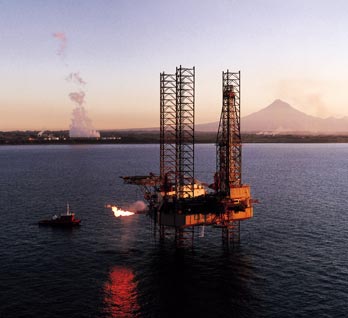Story summary
What are oil and gas?
Oil and gas are also called hydrocarbons or petroleum. They come from under the ground and provide fuel for machines and vehicles, heating, and energy for industries.
Hydrocarbons taken from the ground are a mixture of gases, liquids, semi-solids (waxes) and solids (asphalt, tar and pitch). They must be refined before they can be used.
Oil refinery
Until its closure in 2022, Marsden Point near Whangārei was the only oil refinery in New Zealand. It processed imported crude oil, which supplied most of the country’s petroleum. It also refined a little of the oil found in New Zealand. Most New Zealand oil goes to Australia in an unprocessed state.
How petroleum forms
Most of New Zealand’s petroleum began to form about 20 million years ago. Plants were buried in peat swamps under layers of rock. As they became buried deeper, the heat and pressure in the ground slowly cooked and compressed the material, changing it to oil and gas.
Oil and gas rise to the earth’s surface through gaps in the rock. But where they cannot seep through or around the rock, they become trapped. Geologists survey the ground to find these places several kilometres below the surface, so that companies know where to drill to retrieve the petroleum.
Exploration
Places where oil could be seen on the ground (known as seeps) – the New Plymouth foreshore, the West Coast, and Gisborne – were the first drilling sites. At Moturoa in New Plymouth, gas and oil were found. In 1959, the Kāpuni well, drilled in Taranaki farmland, struck a large amount of gas.
The biggest find was the Māui gas and oil field, off the Taranaki coast, in 1969. This supplied the country with all the gas it needed and some oil. The gas was used to generate electricity, in industry, and some was converted into synthetic petrol. But by the mid-2000s it was nearly all used up. In the late 1900s and early 2000s many small onshore and offshore fields have been found in Taranaki. But New Zealand still imports most of its oil to provide petrol, diesel, aviation fuel and fuel oil.





